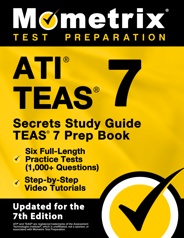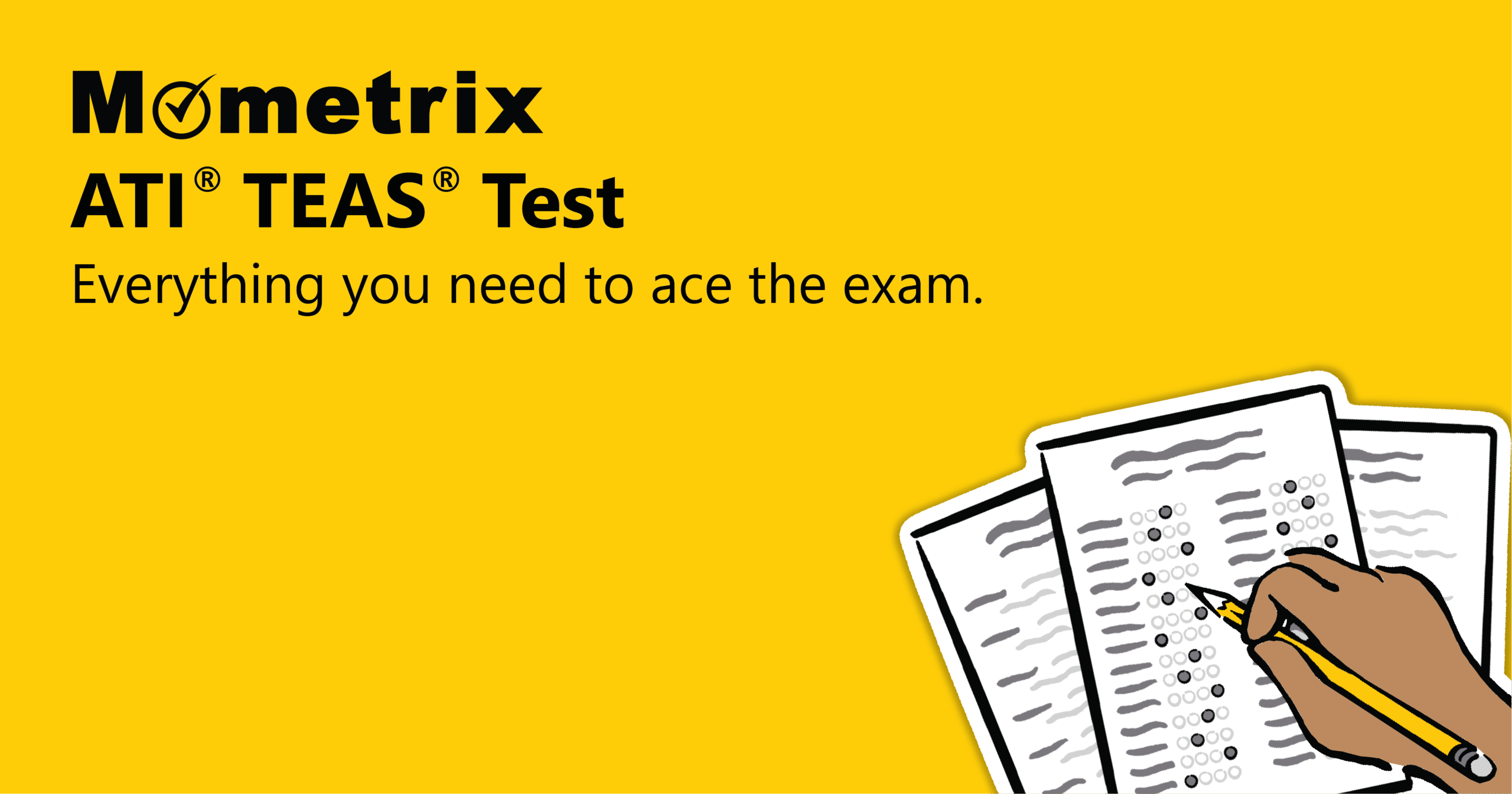Preparing for the TEAS® exam and need test prep resources?
Looking for information about the TEAS exam so you know what to expect and how it works?
In either case, you’ve come to the right place! You’ll find all the information you need about the ATI® TEAS Version 7 exam right here.
If you’re looking for test prep help, just click the buttons below to check out our study guide or online course, both packed with videos, practice tests, and more! Check out the last button to try your hand at a free practice test!
TEAS Checklist
TEAS Test Practice
If you need some extra help preparing for the TEAS, we’ve got you covered! Click below to take a free TEAS 7 practice test:
You cannot apply to nursing school without first taking the TEAS.
If you’ve taken any version of the TEAS that predates the TEAS Version 7 and are planning to apply to nursing school this year, you’ll find your score won’t be accepted. This is to ensure you’re able to handle the newly adapted curriculum found in today’s nursing programs.

TEAS Test Online Prep Course
If you want to be fully prepared, Mometrix offers an online TEAS prep course designed to give you everything you need to succeed!
Here’s what you’ll find in the TEAS course:
Everyone learns differently, so we’ve tailored the TEAS online prep course to ensure every learner has what they need to prepare for the TEAS 7 exam.
Click below to check it out!
Check Out Mometrix's ATI TEAS Study Guide
Get practice questions, video tutorials, and detailed study lessons
Get Your Study Guide
What is the TEAS Test?
The ATI TEAS 7 covers every subject a beginning nursing student will be expected to know upon getting into nursing school.
You can think of the TEAS as you would any other standardized test out there. Much like the ones you took back in high school, the point of the TEAS is to gauge your knowledge. More specifically, the test’s main objective is to assess what aspiring nurses-in-training know prior to entering nursing school.
Before we go into what these specific skills are, we want to clarify that there will be nothing on the TEAS 7 that you haven’t already seen before. In fact, the material included on the exam will never go beyond subjects you learned throughout middle and high school.
TEAS 7 Exam Outline
The TEAS 7 spans 170 questions total; however, your score will only be affected by 150 of these questions. The other 20 sample questions will evaluate you differently, as they’re meant for pretesting purposes and grant no actual points toward your score. The few unscored questions you’ll find serve as what could potentially appear on future releases of the exam and are meant to gauge which questions should be included and which could be too challenging or otherwise unfitting.
On the TEAS 6, multiple-choice questions were the only type of questions you were given. This changed on the TEAS 7. The computerized version of the TEAS 7 features four new question types in addition to multiple-choice:
Multiple-choice questions provide four answer choices, with only one option available to select as the correct answer. In addition to text, some questions include charts, exhibits, and graphics.
Multiple-select questions provide four or more answer choices, and more than one answer choice may be correct. For these questions, a prompt appears, asking you to “select all that apply.” To correctly answer a question, you must select all correct answers. If you select any incorrect answer choices and/or do not select all of the correct answer choices, that question is scored as incorrect; no partial credit is given.
Which of the following transitional words or phrases can be used to indicate contrast? (Select all that apply.)
Supply answer questions do not provide answer choices. Instead, the question asks you to “fill in the blank” or to simply answer the question provided. Words and numbers are both acceptable as answers.
Complete the sentence:
Lisa has $40, and each case of cola costs $3.50, so she can buy a total of cases of cola.
Hot spot questions provide an image containing between two and five clickable areas. You must click on the area of the image that correctly answers the question.
Select the hot spot that contains the correct answer.
Mariah is numbering the points of a pentagon from 1 to 5. She labels the top point as point 1 and continues clockwise. Which of the following would Mariah label as point 3?

Ordered response questions require you to correctly order a set of given responses. Each question provides between four and six responses, and you must drag each option from a box on the left to a box on the right. If any response option is out of order, the entire question is scored as incorrect; no partial credit is given.
Arrange the following elements in order from least reactive to most reactive:
TEAS 7 Test Sections
Each question on the exam can be split into one of four categories: Reading, Science, Mathematics, and English and Language Usage. The full timespan for the test is 209 minutes, or 3.5 hours, with an additional 10-minute break after the Mathematics section.
Very rarely will you encounter any sort of standardized test that assesses your writing ability but neglects your reading ability. The two unavoidably go hand in hand.
Both doctors and patients will provide you with some sort of written document, often in the form of medical documents. Knowing how to read and interpret them is the second half of communicating effectively and ensuring you will be a valuable asset to any medical staff you join (as well as fit for proper nursing education).
The Reading section contains 45 questions, with a time limit of 55 minutes. There are three categories in this section: Key Ideas & Details, Craft & Structure, and Integration of Knowledge & Ideas. Each of them evaluates a specific, complex nuance of the reading process.
Key Ideas & Details
This category deals with the more objective aspects of writing, specifically within the realm of factual evidence and its usage as well as the structuring of persuasive arguments. To properly answer the 15 questions under this category, you need to know how to:
- Summarize a multi-paragraph text
- Make inferences and draw conclusions about a text’s purpose and meaning
- Demonstrate comprehension of written directions
- Locate specific information in a text
- Analyze, interpret, and apply information from charts, graphs, and other visuals
- Interpret events in a sequence
Craft & Structure
This category centers its 9 questions on the stylistic aspects of writing. Here’s what you will be asked to do:
- Distinguish between fact and opinion
- Use context to interpret the meaning of words and phrases
- Evaluate an author’s purpose in a given text
- Evaluate an author’s point of view in a given text
Integration of Knowledge & Ideas
This category deals primarily with research and evidence. For the 15 questions under this category, you will have to fulfill the following tasks:
- Use evidence from a text to make predictions and inferences and to draw conclusions
- Compare and contrast the themes expressed in one or more texts
- Evaluate an argument
- Evaluate and integrate data from multiple sources across various formats
You would be hard-pressed to find any science-based discipline that doesn’t also utilize math in some shape or form. Nursing is no exception. You’ll constantly have to keep track of numerical information when it comes to your future career, from the rates of a patient’s vitals to the precise dosage to give to a patient for treatment. Numbers will be all around you as an integral part of your field.
Because of this, the TEAS 7 has a section devoted to testing your mathematical abilities for 57 minutes. Spanning 38 questions in length, the Math section will assess two specific question categories: Numbers & Algebra and Measurement & Data.
Numbers & Algebra
This category involves algebraic and numerical properties. For the 16 questions under this category, you will have to work with various types of numerical expressions, ratios, rational numbers, proportions, estimations, and percentages. Here’s what you’ll be asked to do:
- Convert among non-negative fractions, decimals, and percentages
- Perform arithmetic operations with rational numbers
- Compare and order rational numbers
- Solve equations with one variable
- Solve real-world problems using one- or multi-step operations with real numbers
- Solve real-world problems involving percentages
- Apply estimation strategies and rounding rules to real-world problems
- Solve real-world problems involving proportions
- Solve real-world problems involving ratios and rates of change
- Solve real-world situations using expressions, equations, and inequalities
Measurement & Data
This category deals with quantitative data. More specifically, the 18 questions in this section are about various units of measurement, different types of data presentations, and several geometric and statistical properties and principles. Here’s a closer look at what you’ll be asked to do:
- Interpret relevant information from tables, charts, and graphs
- Evaluate the information in data sets, tables, charts, and graphs using statistics
- Explain the relationship between two variables
- Calculate geometric quantities
- Convert with and between standard and metric systems
Nursing and science go hand in hand. Much of medicine relies on scientific thought and experimentation in order to help people receive the medications and cures they need to manage their illnesses. In fact, you will regularly be utilizing scientific processes throughout your nursing career, simply by knowing how the body works.
By the time you finish your training, you’ll know all about how vital signs should properly function and the various signs and symptoms of a wide range of illnesses and disorders. This will enable you to properly pinpoint and diagnose malignant conditions affecting the health of your patients.
The TEAS 7 includes a detailed 60-minute Science test. The full section will feature 50 questions total, 6 of which will not be scored. It will include the following question categories: Human Anatomy & Physiology, Biology, Chemistry, and Scientific Reasoning.
Human Anatomy & Physiology
The 18 questions in this category deal with biological processes of the human body and how its different systems function separately and in cooperation with each other. Here’s a closer look at what you’ll be asked to do:
- Demonstrate knowledge of the general orientation of human anatomy
- Describe the anatomy and physiology of the following systems:
- Respiratory system
- Cardiovascular system
- Digestive system
- Nervous system
- Muscular system
- Male and female reproductive systems
- Integumentary system
- Endocrine system
- Urinary system
- Immune system
- Skeletal system
Biology
The 9 questions in this category deal with various aspects of cell structure, protein structure, and microorganisms. Here’s a closer look at what you’ll be asked to do:
- Describe cell structure, function, and organization
- Describe the relationship between genetic material and the structure of proteins
- Apply concepts underlying Mendel’s laws of inheritance
- Describe the structure and function of the basic macromolecules in a biological system
- Describe the role of microorganisms in disease
Chemistry
The 8 questions in this section relate to various aspects of chemical reactions, atomic structure, acids and bases, and properties of matter. Here’s a closer look at what you’ll be asked to do:
- Recognize basic atomic structure
- Know the physical properties and changes of matter
- Describe chemical reactions
- Demonstrate how conditions affect chemical reactions
- Understand properties of solutions
- Describe concepts of acids and bases
Scientific Reasoning
The 9 questions in this section deal with scientific knowledge on an elementary level. Here’s a closer look at what you’ll be asked to do:
- Use basic scientific measurements and tools
- Apply logic and evidence to a scientific explanation
- Predict relationships among events, objects, and processes
- Apply the scientific method to interpret a scientific investigation
“Why is this on a nursing exam?” you may wonder. For starters, it will be your job to communicate with a vast myriad of patients, colleagues, and higher-ups on a daily basis once you officially begin your nursing career. In order to communicate effectively, you’ll have to know the basics, which comes down to knowing how to write and form your ideas coherently. This will enable you to better realize how to respond to the various situations you’ll encounter as a nurse and pick your words carefully.
On a more immediate note, you’ll also certainly be expected to write your fair share of essays and other reports throughout the duration of your nursing education. You cannot succeed and/or graduate without knowing how to efficiently get your ideas across.
There are 37 questions on this portion of the test, and you’ll have 37 minutes to complete the full section, giving you one minute to answer each question.
Each question on the English and Language Usage section falls under one of three categories: Conventions of Standard English, Knowledge of Language, and Using Language and Vocabulary to Express Ideas in Writing. To help you better understand what each of these categories means and how to recognize questions falling under them, we will go over all three individually.
Conventions of Standard English
The 12 questions in this category cover some of the basic knowledge, skills, and abilities relating to the conventions of standard English. Here’s a closer look at what you’ll be asked to do:
- Use conventions of standard English spelling
- Use conventions of standard English pronunciation
- Use correct sentence structures
Knowledge of Language
The 11 questions in this category evaluate your comprehension of how language can be used in writing. Here’s a closer look at what you’ll be asked to do:
- Use grammar to enhance clarity in writing
- Evaluate if language meets the needs of a particular audience
- Develop a well-organized paragraph
Using Language and Vocabulary to Express Ideas in Writing
The 10 questions in this category test your ability to communicate your ideas effectively in writing by using higher-level vocabulary and grammar. Here’s a closer look at what you’ll be asked to do:
- Apply basic knowledge of the elements of the writing process to communicate effectively
- Determine the meanings of words by analyzing word parts
Check Out Mometrix's ATI TEAS Flashcards
Get complex subjects broken down into easily understandable concepts
Get Your Flashcards
TEAS vs. HESI
The TEAS 7 and the HESI A2 are both entrance exams for nursing school. Wondering which exam is right for you?
Take a look at the details of each exam here:
| TEAS | HESI A2 | |
|---|---|---|
| Time | 3 hours and 29 minutes | 4 hours (estimate varies based on sections) |
| Question Count | 170 questions | 326 questions (estimate varies by institution and sections selected) |
| Sections | 4 | Up to 9 |
| Subjects |
|
|
| Test Dates | Available year-round through testing centers or remote proctoring | Scheduled by individual schools or testing centers |
| Registration | Online or at participating institutions | Online |
| Fee | $115–$140 (estimate depends on testing format and location) | $40–$100 (estimate varies by institution) |
| Fee Waiver | No | Varies by institution |
| Receive Score | Immediate unofficial scores for computer-based; official scores in 48 hours. | Immediate for most sections; writing sections may take a few days. |
| Option to Retake | Allowed every 30 days; typically 2–3 attempts per year (varies by institution) | Determined by individual schools (often 2–3 attempts per year) |
| Pass or Fail | No (passing score varies by program) | No (passing score varies by institution) |
| Time | |
|---|---|
| TEAS | HESI A2 |
| 3 hours and 29 minutes | 4 hours (estimate varies based on sections) |
| Question Count | |
|---|---|
| TEAS | HESI A2 |
| 170 questions | 326 questions (estimate varies by institution and sections selected) |
| Sections | |
|---|---|
| TEAS | HESI A2 |
| 4 | Up to 9 |
| Subjects | |
|---|---|
| TEAS | HESI A2 |
|
|
| Test Dates | |
|---|---|
| TEAS | HESI A2 |
| Available year-round through testing centers or remote proctoring | Scheduled by individual schools or testing centers |
| Registration | |
|---|---|
| TEAS | HESI A2 |
| Online or at participating institutions | Online |
| Fee | |
|---|---|
| TEAS | HESI A2 |
| $115–$140 (estimate depends on testing format and location) | $40–$100 (estimate varies by institution) |
| Fee Waiver | |
|---|---|
| TEAS | HESI A2 |
| No | Varies by institution |
| Receive Score | |
|---|---|
| TEAS | HESI A2 |
| Immediate unofficial scores for computer-based; official scores in 48 hours. | Immediate for most sections; writing sections may take a few days. |
| Option to Retake | |
|---|---|
| TEAS | HESI A2 |
| Allowed every 30 days; typically 2–3 attempts per year (varies by institution) | Determined by individual schools (often 2–3 attempts per year) |
| Pass or Fail | |
|---|---|
| TEAS | HESI A2 |
| No (passing score varies by program) | No (passing score varies by institution) |
TEAS Test Dates
One of the benefits of this exam is that it’s available year-round on a weekly basis, meaning you can schedule to take the test when you feel absolutely ready. ATI doesn’t require you to take the test on a limited number of weekends like many other testing organizations.
ATI® and TEAS® are registered trademarks of the Assessment Technologies Institute®, which is unaffiliated, not a sponsor, or associated with Mometrix Test Preparation.









